藝術家傅文俊的數繪攝影之構圖和表現方式流露出極致的視覺效果。藝術家們常以過去與現在的發展為創作靈感,傅文俊亦如是,他如畫的攝影風格與路易·達蓋爾(1787-1851)在1820年代初期的攝影作品的繪畫性關系密切。傅文俊的當代作品雖然蘊藏與繼承了上述特質,但在技巧上卻未受路易·達蓋爾的風格所限,亦絕非純粹的繪畫;它乃是在單色和彩色攝影方面,建立出一種深深植根于多層中國文化的語言。
傅文俊的數繪攝影常被譽為富有詩意。詩歌是一種以文本為基礎的媒介,通過文字描述來激發讀者的想象力,思考能呈現出口語對話內容的圖像。在傅文俊的數繪攝影中,影像是最重要的,圖像內容則是一種敘述。觀眾欣賞他的作品時,不像在閱讀一則圖畫故事,而是更多地投入于一種視覺內容上的哲學思考。如此,文字與影像合而為一,在觀眾的腦海里擦出火花,使作品的歷史與文化涵義變得完整。
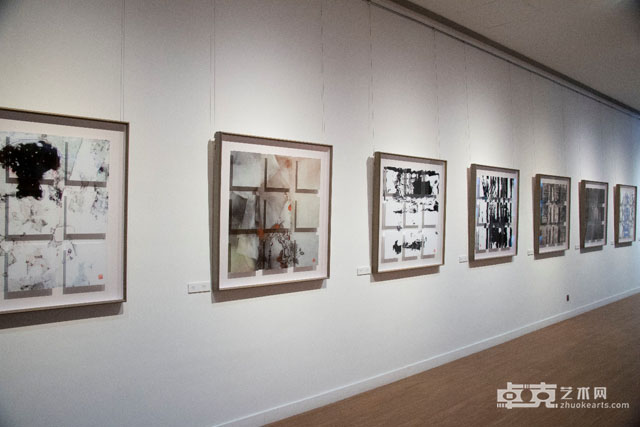
《相機繪畫:傅文俊的攝影創作》展覽,香港大學
“數繪攝影”是傅文俊的創作理念,它重新闡釋攝影藝術核心的傳統,并在其作品展中表露無遺,最近在香港大學舉辦的傅文俊作品展即為一例(圖1)。這位藝術家在創作過程中融入其他藝術媒介的元素,開創了美學上一種擁抱各類藝術形式、嶄新的愉悅體驗。
傅文俊的創作技巧在表現手法和歷史涵義上均有文化參照。當他描繪中國藝術和建筑,或采用象征元素時,傅文俊會以中國水墨畫的主題與技法作為繪畫構圖的創作靈感。通過揭示攝影與其他藝術模式而相得益彰,傅文俊將那看似艱澀難懂的信息轉化成極易掌握的概念,從而引發有關歷史、社會和人文的批判思考。
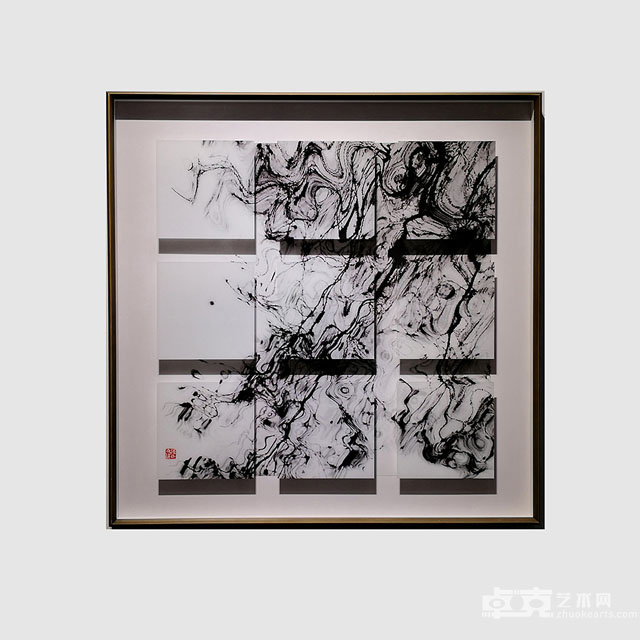
《空山新雨后》
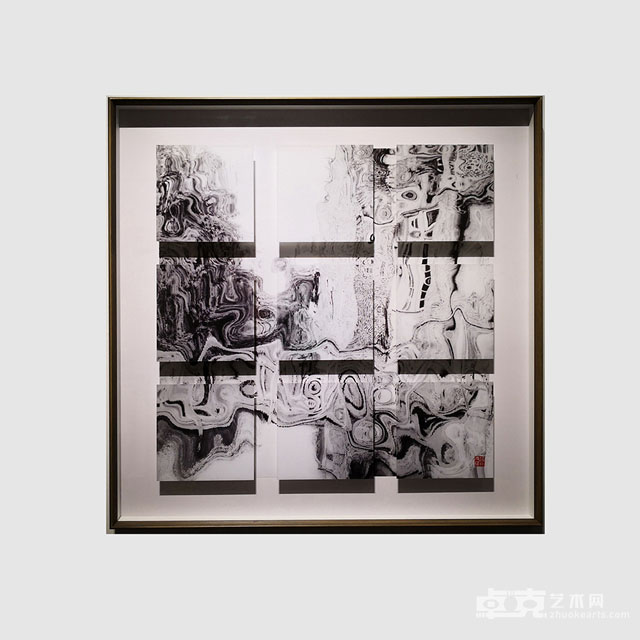
《小樓咋夜又東風》
傅文俊在《空山新雨后》、《小樓咋夜又東風》、《行到水窮處》(圖2-4;數繪攝影,100 x 100 厘米,2017─2018)中揮灑墨水,繪出一組三乘三的浮凸方格,反映陰影與空間把主圖墨跡層層延伸。眾多作品中所展現的分層效果,可見他力求打破攝影規范。對傅文俊而言,一張照片可被切割和延展,在它與空間和光線互動時,創出一個全新的藝術角度。在同一個光與暗互相輝映的立體圖像中,不同色調的灰色與深黑色的變化并置呈現。
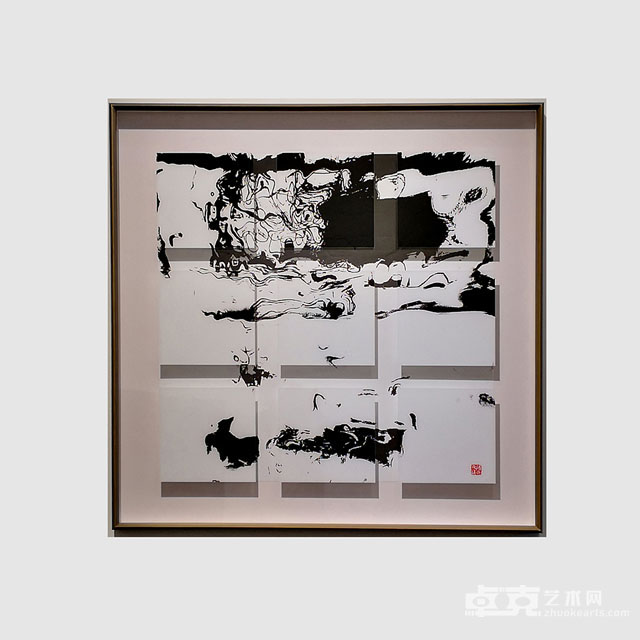
《行到水窮處》
正如傳統的黑白照片一樣,對比效果是賦予影像活力的重要元素。傅文俊的作品與水墨畫的視覺聯系,正提醒著觀眾,濕潤的黑色和畫家揮動(畫筆)筆觸時產生的明暗墨痕是同樣重要的。多個世紀以來,畫家們一直苦練如何透過畫筆來呈現水墨的濃淡效果。在傅文俊作品的光影意趣中,傳統中國文化對“墨韻五色”(即干、濕、濃、淡、黑)的應用、干墨與濕墨之間的細微差別、或墨染畫的朦朧效果,都一一隱藏了。
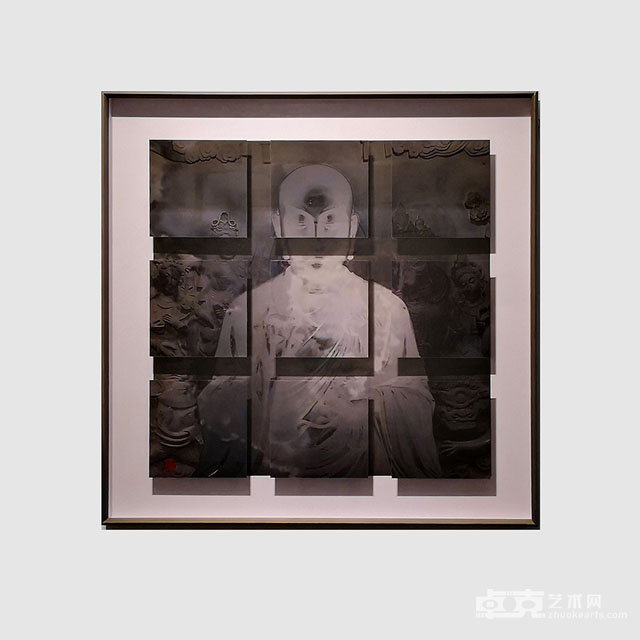
《不二法門》
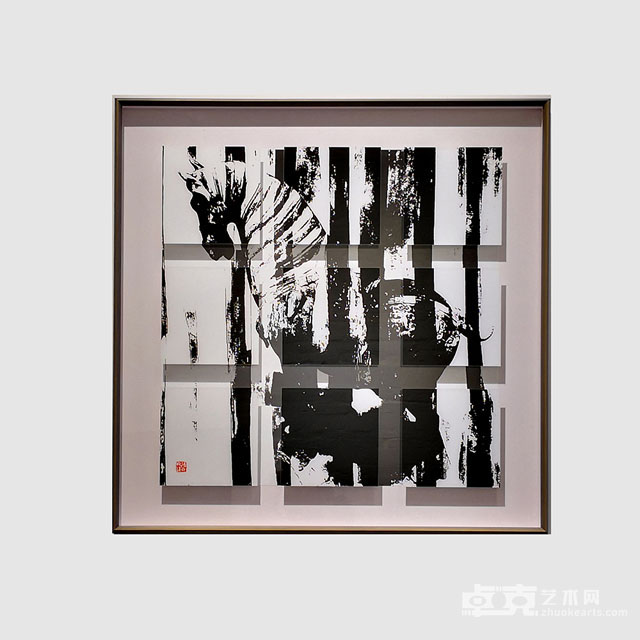
《寶馬》
《不二法門》、《寶馬》(圖5-6;數繪攝影,100 x 100 厘米,2017─2018)等作品以抽象的構圖描繪佛陀和唐代寶馬。兩張作品并非直接描繪佛陀或寶馬,而是一個側面描繪,主題就像被一層輕紗遮蓋著,與畫筆下如夢似的圖像非常相似。傅文俊作品的傳統面貌不僅限于技巧表達,更包含融合了當代攝影和古代中國藝術形式,特別是立體雕塑的圖像;這就像上文提及的光影意趣,實為平面與立體之間的對話。
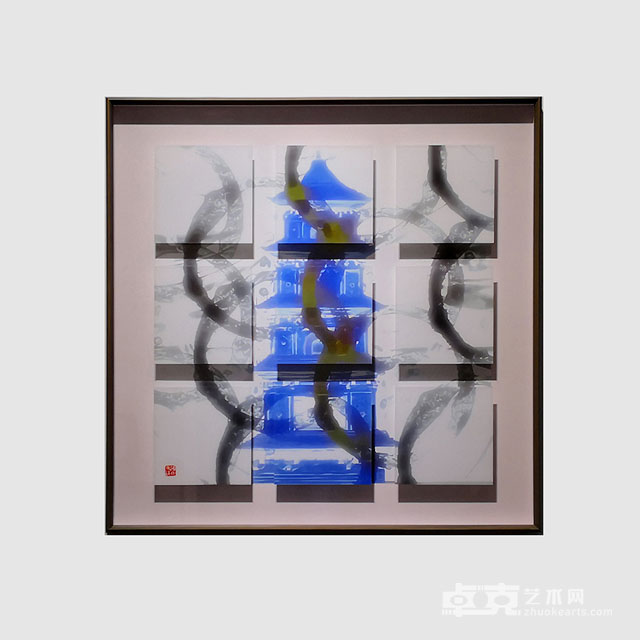
《緣來緣去》
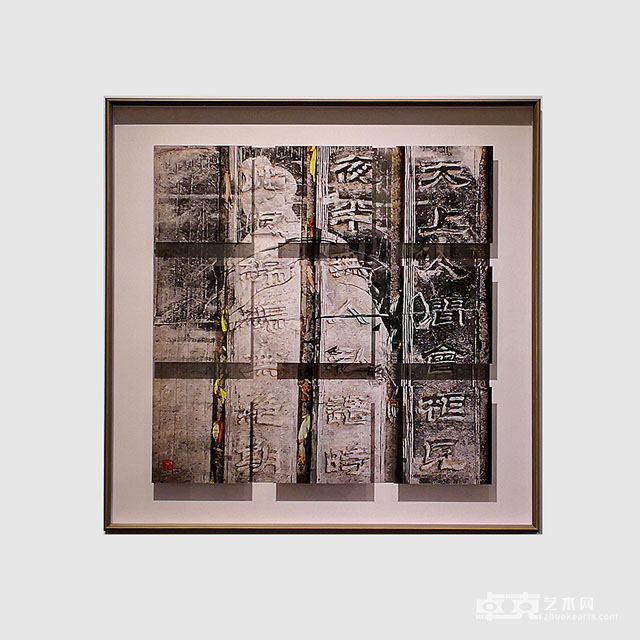
《無人私語》
傅文俊在《緣來緣去》和《無人私語》(圖7-8;數繪攝影,100 x 100 厘米,2017─2018))兩幅攝影作品中,運用顏色來豐富創作主題。他的單色影像與水墨畫產生強烈共鳴,其彩色攝影卻散發出中國木刻版畫的特征。那代表寶塔的淡藍色調,構成一個由木版墨痕造成的和諧統一的影像。這種特質和重疊的環形圖案,塑造出另一種立體的幻象;又或者可以說是一幅簾子或一塊動人的面紗。
《無人私語》中的“面紗”由一連串的中文文字構成。傳統有謂書畫同源,皆因兩者都以毛筆和水墨創作。傅文俊的攝影作為現代媒介,聯系和拓展了傳統的轉印技法;不管他是否有意為之,其作品的確使“書畫同源”這一概念更為充實。
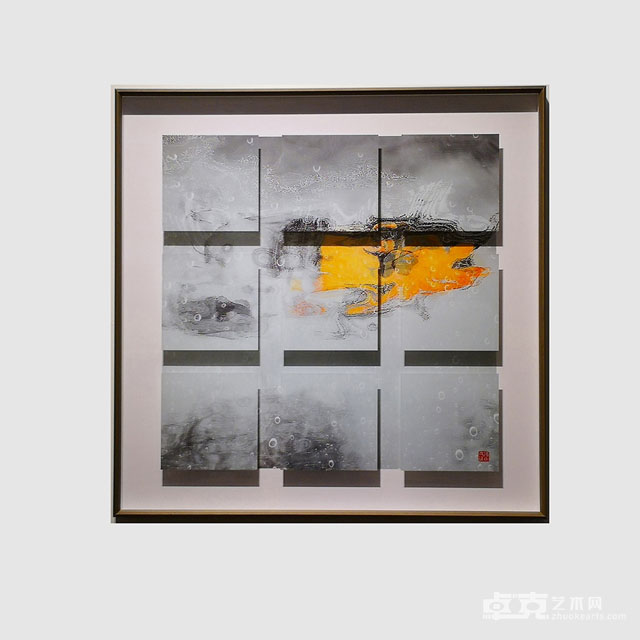
《大珠小珠落玉盤》
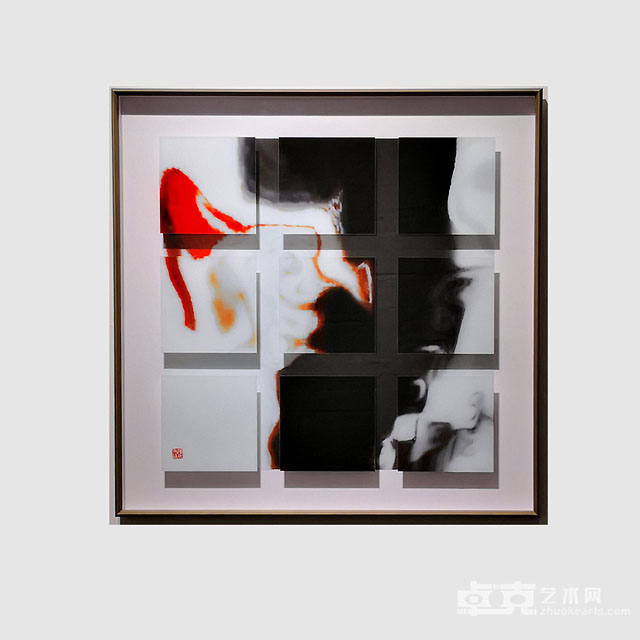
《更待江南半月春》
傅文俊作品中另一項值得關注的地方在于他對色塊的運用——那讓人聯想起新水墨運動的元素。《大珠小珠落玉盤》和《更待江南半月春》(圖9-10;數繪攝影,100 x 100 厘米,2017─2018)兩幅色彩配搭看似簡單的作品里,墨韻氣息相當濃厚;傅文俊并非只是簡單地混合色彩,而是利用在不同的獨立方塊區域來創造畫面的深度和饒富趣味的并置效果。立體對象的描繪、光影的意趣、對比色彩的聯想等多層元素,組成一幅深入而層次豐富的構圖。
傅文俊藝術創作的本質建基于多個文化涵義:他的攝影將傳統繪畫風格與技巧、傳統圖像與一種未有明確定義、看似蓋著一塊面紗般隱秘卻是有助凝聚起各種媒體的表現手法等連接起來。作品內流暢的墨韻全是中國元素,但與木刻版畫相關的圖像卻又可能與東方和西方文化風格相關,因它們帶有曼·雷(1890–1976)與安迪·沃霍爾(1928–1987)藝術風格的影子。不過,將雕塑和建筑主題結合,并將中文文字融入抽象的繪畫性當代攝影之中,正是傅文俊新穎的藝術形式的標志。
這一系列的作品分析,進一步帶出幾個額外、且并非傅文俊作品或一般攝影所獨有的事實。傅文俊的作品呈現出技法和大小相同的影像,所有的攝影都是由九個體積較細小的方塊組合而成的大方塊(100 x 100 厘米),以達致多層效果。這種方塊設計營造出一個工整規范、重復密集的視覺效果;當中只有作品的主題有所變化。每張攝影的內容與其他攝影的并非必然相關;唯有當個別方塊在特定大主題下組成一對或一組時,它們才算屬于同樣的主題。由此可見,傅文俊的數繪攝影所呈現的并非傳統設計構圖上的協調,而是技巧的統一。觀眾能從中明白,他的攝影帶來一種印制和裝裱攝影的新方法。該方法本身就是一種藝術,一種能將視覺表現方式獨立于描繪主題的方式。
傅文俊的攝影蘊藏豐富多樣的文化與藝術涵義、視覺關系和裝裱技藝,為觀眾帶來意想不到的體驗。他的影像既非全然抽象,亦非紀實攝影。其攝影感染力的糅合與解讀,為我們帶來一種源于達蓋爾的時代、用以重現自然的新藝術形式。文字的加入使不同的元素在傅文俊的視覺作品內得以重新調配,從而激發起引領我們突破傳統數碼攝影框框的想象力。
羅諾德,2019年5月
關于作者:羅諾德博士(Florian Knothe),藝術史學家和博物館專家,香港大學美術博物館館長,并教授藝術史和博物館研究。
Fu Wenjun's Digital Pictorial Photography
By Florian Knothe
The visual quality of Master Fu Wenjun’s Digital Pictorial Photography is apparent in terms of both its composition and presentation. As artists make reference to the past and its continuous development, Fu has related his own painting-like presentations to the painterly quality of Louis-Jacques Daguerre's (1787–1851) photographs from the early 1820s. Beyond this reference and lineage, his contemporary work is neither technically limited in the way that Daguerre's was, nor is it merely pictorial. In both mono- and polychrome applications, Fu has developed a language that is indicative of a rapport with deeply engrained layers of Chinese culture.
Fu's digital work has been described as poetic. Poetry is a text based medium that describes in words and evokes the readers’ fantasy to think of images to illustrate the verbal dialogue. In Fu's form of digital photography, the image comes first and the pictorial content suggests a narrative. Rather than a story in pictures, Fu’s viewer engages more philosophically with the visual content. Text and image become one and provoke each other to complete, in a viewer's mind, the historical or cultural connotations being displayed.?
Exhibitions of Fu’s work (Figure 1), such as the recent display at the University of Hong Kong, demonstrate how his creative output can be summed up through the concept of ‘Digital Pictorial Photography’, which is his reworked term for the traditions found at the core of the photographic arts. By blending elements of other modes of fine art into the photographic process, he has created a new form of aesthetic pleasure that embraces a range of artistic media.
Fu’s technique puts forward cultural references on both a technical and historical level, as his pictorial compositions relate to Chinese ink painting in both technique and subject matter, as they depict Chinese art and architecture or include symbolic elements. By demonstrating the complementary relationship of photographs and other modes of fine art, Fu is able to transform a seemingly inaccessible message into a highly approachable idea that then can trigger critical thought about history, society and humanity.
Artworks such as After Fresh Rain in the Mountains, East Wind Blew Again Last Night and Where the Water Ends (Figures 2–4; digital pictorial photography, 100 x 100 cm, 2017–2018) showcase Fu’s lavish use of ink, which here forms a set of squares that reflects both shadow and space, further expanding the inked image. The effect of layering found in much of his art is a prime example of how he strives to break photographic norms. For Fu, a photograph can be dissected and expanded so as to interact with space and light in the creation of new artistic perspectives. The differing shades of grey and gradation to a deep black are juxtaposed within the same three-dimensional presentation of light and dark.
As in traditional black-and-white photography, contrast brings liveliness to the images. The visual relationship with ink painting further reminds the viewer that the saturation of the black and the (brush) flow’s darker and lighter traces are of consequence. For centuries, painters trained the handling of the brush to master the application of solid to diluted watery ink. The culture of applying the traditional ‘five ink tones’ (dark dry ink, dark heavy ink, heavy ink, light ink and bland ink)—as well as the nuances found in dry and wet ink, or the blurred spread in ink-wash paintings—are eluded to in Fu’s interplay of light and shadow.
Images such as The One and Only Way and Precious Horse (Figures 5–6; digital pictorial photography, 100 x 100 cm, 2017–2018) combine the abstract composition with depictions of a Buddha and Tang era horse. Both images are not straight forward depictions, but instead illustrate artworks that appear as if they are being seen through a veil, reminiscent of the dreamy representation of the brush. The traditional aspects of Fu’s work reach beyond technical skill and incorporate an iconography that relates these contemporary photographs to ancient Chinese art forms, especially to sculptures—objects in the round—that, like the earlier shadow play, return to a dialogue about two and three dimensions.
In the photographs Come and Go and Nobody to Talk With (Figures 7–8; digital pictorial photography, 100 x 100 cm, 2017–2018), the master photographer expands his theme by employing colour. Whereas his monochrome images are strongly related to ink painting, his colour photography resembles the characteristics of Chinese woodblock printing. The seemingly subtle application of blue to represent the pagoda suggests a uniform image created by the inked impression of a printing block. This quality, together with the overlaying ring motif, creates another illusion of three-dimensionality; or, put differently, a curtain or emotional veil.
In Nobody to Talk With, this ‘veil’ is composed of a string of Chinese characters; a traditional aphorism which proposes that painting and calligraphy are related, as they both arrive with the brush and ink. Whether deliberate or not, Fu’s photography extends this theme, as his modern medium relates to and extends these traditional techniques of image transfer.
A further development is the introduction of patches of colour, an element in Fu’s work that is reminiscent of compositions from the New Ink Painting Movement. In Dancing Notes and Stay More in Spring (Figures 9–10; digital pictorial photography, 100 x 100 cm, 2017–2018) an inky quality prevails through the seemingly simple application of colour in adjacent, though separate, individual areas. A depth and interesting form of juxtaposition are created by working within these discrete areas, rather than by simply mixing the colours. As with the layering of elements, the representation of three-dimensional objects and the interplay of light and shadow, the association of contrasting colours evokes a deep and multi-layered composition.
The quality of Fu’s artistic production lies in its multiple connotations: his photography creates a link between conventional painting styles and techniques, between traditional iconography and a less defined expression that may seem like a veil but, actually helps to bind together the media. While the ostensibly fluid ink is entirely Chinese, his wood block print-related images may relate to Eastern as well as Western forms of culture, as they contain stylistic precedents that are also found in the work of Man Ray (1890–1976) and Andy Warhol (1928–1987). However, the incorporation of sculptural and architectural topics, as well as Chinese characters in contemporary photography with abstract painterly tones, is the trademark of Fu’s innovative art form.
The analytical focus on this series further highlights a number of additional facts that are neither particular to Fu’s work nor to photography in general. His project presents images of identical technique and size. All of the photographs are large squares (100 x 100 cm) that incorporate nine smaller squares to achieve this layered effect. In so doing, Fu displays a highly regular structure in which the effect is repeated—and intensified—while only the subject matter differs. The contents of individual photos do not necessarily relate to one another, as only certain pairs or small groups within the larger project adhere to similar themes. The artist presents a unity via technique rather than a traditional graphic composition. Viewers come to realize that Fu’s photography introduces a way to print and mount photographs that is an art in itself, which prevails as an application that leads the visual presentation independently from the depicted subject matter.
With such an array of varied cultural and artistic connotations, visual relationships and mounting techniques, Fu’s photography challenges viewers and presents something quite unexpected. His images are neither predominantly abstract nor documentary in nature. The combination and interpretation of his photographic influences offers a new employment of a form that was originally introduced—in Daguerre's days—for the reproduction of nature. These various elements realign in his visual work by incorporating texts so as to stimulate a fantasy that leads viewers beyond conventional forms of digital photography.
Florian Knothe, May 2019
About the author: Florian Knothe is an art historian and museum professional. He directs the University Museum and Art Gallery at HKU, and teaches art history and museum studies.






 皖公網安備 34010402700602號
皖公網安備 34010402700602號